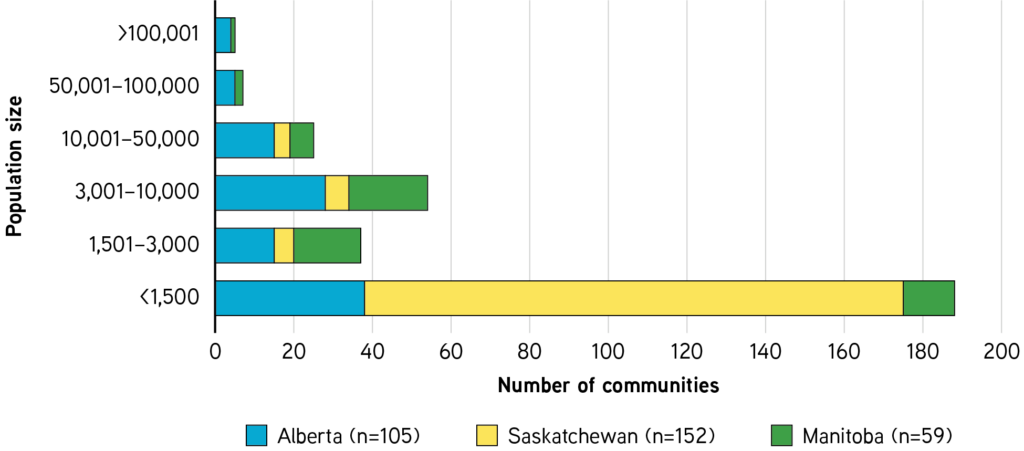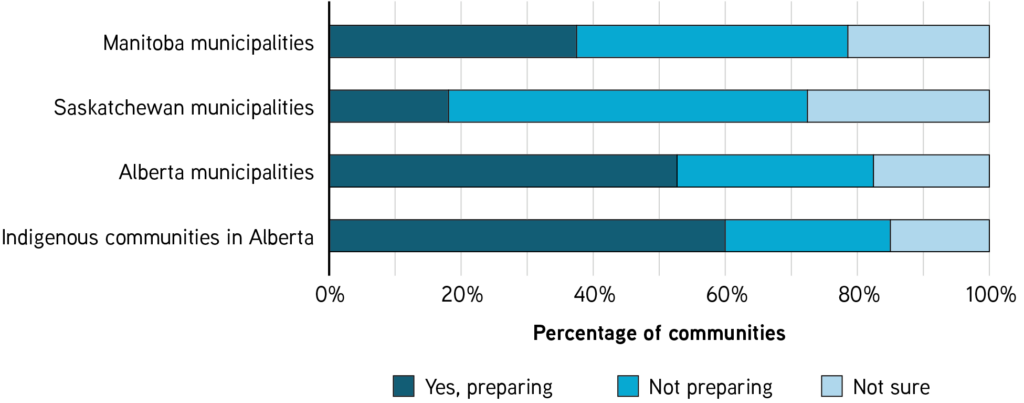31 Jan, 2022
Survey Results are in: Are Prairie Communities Prepared for Climate Change?
Given the extreme weather events the Prairies experienced in 2021—everything from extensive drought in many parts, to a record setting wildfire season in Manitoba, to the weeks-long deep freeze underway—it is worth asking: how ready are Prairie communities for the impacts of a changing climate?
The Prairies Regional Adaptation Collaborative (PRAC) set out to shed light on this question in a first of its kind survey across the Prairies. Conducted over the fall and winter of 2020-2021, the PRAC, working with the All One Sky Foundation, reached out to municipalities and Indigenous communities throughout Alberta, Saskatchewan, and Manitoba to better understand the current extent of their climate change adaptation needs, planning, and implementation.
The survey yielded a strong response: Nearly 300 communities took the time to reply —capturing 22% of all Prairie-based communities from large cities to small hamlets and rural municipalities.

The recently released report provides an overview of the survey’s main outcomes and full results. The summary below highlights only a select number of results.
What are the key findings?
Although Prairie communities are thinking about climate change, the survey results suggest communities are not as prepared as they need to be. On average across Alberta, Saskatchewan, and Manitoba:
- Only 5% of the communities’ surveyed had completed a formal climate adaptation plan or strategy.
- 8% of the responding communities had completed a climate change risk and vulnerability assessment
And yet:
- 80% of respondents indicated that their community had experienced one or more unusual extreme weather or weather-related events in the past decade.
- 75% of respondents shared significant concern about their changing climate risks and the associated impacts on their infrastructure, community members and local industries.
The trends grow more interesting with a deeper dive into each of the Prairie provinces:

- More than 50% of municipalities in Alberta indicated that they are preparing for local climate change impacts, while fewer than 20% of communities in Saskatchewan were making preparations.
- 14% of communities in Manitoba and 15% of communities in Alberta stated that they had completed a climate risk and vulnerability assessment, whereas no responding communities in Saskatchewan had taken this step.
- A higher percentage of Manitoban communities (14%) reported that they had completed a climate adaptation plan or strategy compared to communities in Alberta (9%) and Saskatchewan (2%)—but regardless of province, there is tremendous room to do more preparation and planning.
The experience also differed between communities of different sizes:
- 70% of larger communities (with a population of 10,000 or more) said they are preparing for climate change, whereas less than 30% of smaller communities (fewer than 10,000 people) were taking similar actions.
Very notable are the Indigenous communities leading the way:
- Indigenous communities in Alberta emerged as leaders in climate change preparations. While most of these communities have a population of fewer than 10,000 people, among the 20 respondents, 60% stated that they are taking action to prepare for climate change.
The good news is that once communities have prepared an adaptation plan or strategy, 70% have taken, or are taking, steps to implement them. Unfortunately, it is also clear that many communities across the Prairies are still facing barriers when it comes to adaptation planning, including a lack of financial support and technical capacity.
To learn more about the climate adaptation priorities, progress and needs of Prairie communities, check out the full report.
So how do Prairie communities compare to the readiness of communities in other parts of Canada?
Unfortunately, we really can’t say as comparable survey results have not yet been identified. This speaks more broadly to the fact that climate change adaptation has received less focus and investment. Excellent reports recently completed by IISD or the Canadian Institute on Climate Choices bring home this point.
Although the PRAC has wrapped up its decade-plus of activity, ClimateWest is picking up where it leaves off. Regardless of what stage your community is at—from getting started to charting next steps for an adaptation plan—ClimateWest is here to help on your adaptation journey!
Contact us through our Help Desk or email us at info@climatewest.ca. You can also subscribe to our newsletter to stay updated on climate adaptation resources across the Prairies.
